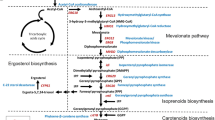Abstract
The yeast Xanthophyllomyces dendrorhous is one of the rare organisms which can synthesize the commercially interesting carotenoid astaxanthin. However, astaxanthin yield in wild-type and also in classical mutants is still too low for an attractive bioprocess. Therefore, we combined classical mutagenesis with genetic engineering of the complete pathway covering improved precursor supply for carotenogenesis, enhanced metabolite flow into the pathway, and efficient conversion of intermediates into the desired end product astaxanthin. We also constructed new transformation plasmids for the stepwise expression of the genes of 3-hydroxymethyl-3-glutaryl coenzyme A reductase, geranylgeranyl pyrophosphate synthase, phytoene synthase/lycopene cyclase, and astaxanthin synthase. Starting from two mutants with a 15-fold higher astaxanthin, we obtained transformants with an additional 6-fold increase in the final step of pathway engineering. Thus, a maximum astaxanthin content of almost 9 mg per g dry weight was reached in shaking cultures. Under optimized fermenter conditions, astaxanthin production with these engineered transformants should be comparable to Haematococcus pluvialis, the leading commercial producer of natural astaxanthin.




Similar content being viewed by others
References
Andrewes AG, Starr MP (1976) (3R,3′R)-Astaxanthin from the yeast Phaffia rhodozyma. Phytochem 15:1009–1011
Borovkov AY, Rivkin MI (1997) XcmI-containing vector for direct cloning of PCR products. BioTechn 22:812–814
Breitenbach J, Visser H, Verdoes JC, van Ooyen AJ, Sandmann G (2011) Engineering of geranylgeranyl pyrophosphate synthase levels and physiological conditions for enhanced carotenoid and astaxanthin synthesis in Xanthophyllomyces dendrorhous. Biotechnol Lett 33:755–761
de Boer L, Van Hell B, Krouwer AJJ (1993) Strains of Phaffia rhodozyma containing high levels of astaxanthin and low levels of 3-hydroxy-3′,4′-didehydro-beta-ψ-caroten-4- one (HDCO). US patent no. 5648261
Gassel S, Schewe H, Schmidt I, Schrader J, Sandmann G (2013) Multiple improvement of astaxanthin biosynthesis in Xanthophyllomyces dendrorhous by a combination of conventional mutagenesis and metabolic pathway engineering. Biotechnol Lett 35:565–569
Gritz L, Davies J (1983) Plasmid-encoded hygromycin B resistance: the sequence of hygromycin B phosphotransferase gene and its expression in Escherichia coli and Saccharomyces cerevisiae. Gene 25:179–188
Hanna Z, Fregeau C, Préfontaine G, Brousseau R (1984) Construction of a family of universal expression plasmid vectors. Gene 247:247–250
Johnson EA, Schroeder WA (1995) Microbial carotenoids. Adv in Biochem Eng Biotechnol 53:119–178
Krügel H, Fiedler G, Haupt I, Sarfert E, Simon H (1988) Analysis of the nourseothricin-resistance gene (nat) of Streptomyces noursei. Gene 62:209–217
Lorenz R, Cysewski G (2000) Commercial potential for Haematococcus microalgae as a natural source of astaxanthin. Trends Biotechnol 18:160–167
Margalith PZ (1999) Production of ketocarotenoids by microalgae. Appl Microbiol Biotechnol 51:431–438
Misawa N, Satomi Y, Kondo K, Yokoyama A, Kajiwara S, Saito T, Ohtani T, Miki W (1995) Structure and functional analysis of a marine bacterial carotenoid biosynthesis gene cluster and astaxanthin biosynthetic pathway proposed at the gene level. J Bacteriol 177:6575–6584
Ojima K, Breitenbach J, Visser H, Setoguchi Y, Tabata K, Hoshino T, van den Berg J, Sandmann G (2006) Cloning of the astaxanthin synthase gene from Xanthophyllomyces dendrorhous (Phaffia rhodozyma) and its assignment as a beta- carotene 3-hydroxylase/4-ketolase. Mol Genet Genomics 275:148–158
Rodriguez-Saiz M, de la Fuente JL, Barredo JL (2010) Xanthophyllomyces dendrorhous for the industrial production of astaxanthin. Appl Microbiol Biotechnol 88:645–658
Sandmann G (2002) Combinatorial biosynthesis of carotenoids in a heterologous host: a powerful approach for the biosynthesis of novel structures. Chem BioChem 3:629–635
Schmidt I, Schewe H, Gassel S, Jin C, Buckingham J, Hümbelin M, Sandmann G, Schrader J (2011) Biotechnological production of astaxanthin with Phaffia rhodozyma/Xanthophyllomyces dendrorhous. Appl Microbiol Biotechnol 89:555–571
Seybold A, Goodwin TW (1959) Occurrence of astaxanthin in the flower petals of Adonis annua L. Nature 184:1714–1715
Shimada H, Kondo K, Fraser PD, Miura Y, Saito T, Misawa N (1998) Increased carotenoid production by the food yeast Candida utilis through metabolic engineering of the isoprenoid pathway. Appl Environ Microbiol 64:2676–2680
Verdoes JC, Krubasik KP, Sandmann G, van Ooyen AJ (1999a) Isolation and functional characterisation of a novel type of carotenoid biosynthetic gene from Xanthophyllomyces dendrorhous. Mol Gen Genet 262:453–461
Verdoes JC, Misawa N, van Ooyen AJJ (1999b) Cloning and characterization of the astaxanthin biosynthetic gene encoding phytoene desaturase of Xanthophyllomyces dendrorhous. Biotechnol Bioeng 63:750–755
Verdoes JC, Sandmann G, Visser H, Diaz M, van Mossel M, van Ooyen AJ (2003) Metabolic engineering of the carotenoid biosynthetic pathway in the yeast Xanthophyllomyces dendrorhous (Phaffia rhodozyma). Appl Environ Microbiol 69:3728–3738
Verwaal R, Wang J, Meijnen J, Visser H, Sandmann G, van den Berg JA, van Ooyen AJJ (2007) High-level production of beta-carotene in Saccharomyces cerevisiae by successive transformation with carotenogenic genes from Xanthophyllomyces dendrorhous. Appl Environ Microbiol 73:4342–4350
Visser H, Sandmann G, Verdoes JC (2005) Xanthophylls in fungi: Metabolic engineering of the astaxanthin biosynthetic pathway in Xanthophyllomyces dendrorhous. Methods in Biotechnology. Microbiol Processes and Products, Totowa, NJ, USA
Wery J, Verdoes JC, Van Ooyen AJ (1998) Efficient transformation of the astaxanthin-producing yeast Phaffia rhodozyma. Biotechnol Tech 12:399–405
Acknowledgments
This work was funded by the German Federal Ministry of Education and Research (BMBF) (FKZ 0315327).
Author information
Authors and Affiliations
Corresponding author
Rights and permissions
About this article
Cite this article
Gassel, S., Breitenbach, J. & Sandmann, G. Genetic engineering of the complete carotenoid pathway towards enhanced astaxanthin formation in Xanthophyllomyces dendrorhous starting from a high-yield mutant. Appl Microbiol Biotechnol 98, 345–350 (2014). https://doi.org/10.1007/s00253-013-5358-z
Received:
Revised:
Accepted:
Published:
Issue Date:
DOI: https://doi.org/10.1007/s00253-013-5358-z




